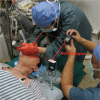Laryngoscopic techniques modulate anaesthesiologists' perception of halitosis in patients: A randomised controlled trial
- PMID: 31644511
- PMCID: PMC6855315
- DOI: 10.1097/EJA.0000000000001115
Laryngoscopic techniques modulate anaesthesiologists' perception of halitosis in patients: A randomised controlled trial
Abstract
Background: Perception of halitosis in patients during intubation is a common and additional stressor for anaesthesiologists and may lead to potential health risks.
Objectives: We hypothesised that intubation with videolaryngoscopy could help reduce the anaesthesiologists' perception of patients' oral malodor during intubation.
Design: A single-blinded, randomised controlled trial.
Setting: Single centre general hospital, Guangdong Province, China.
Participants: A total of 440 patients who underwent intubation under general anaesthesia for elective surgery, aged 18 to 60 years old, American Society of Anaesthesiologists class I to III, without upper airway abnormality or airway infection were enrolled.
Intervention: Patients were randomly assigned to receive either UE videolaryngoscopy (UE) or Macintosh's direct laryngoscopy (Macintosh) group. All intubations were performed by one of six very experienced anaesthesiologists.
Main outcome measures: The patient's oral odour score was measured prior to induction of anaesthesia. The anaesthesiologists' perception of the patient's oral malodor during intubation was recorded. The shortest distance from patient's mouth to the anaesthesiologist's nose (MN distance), the exertion rating and discomfort were also measured.
Results: The oral malodor score did not differ in the UE and Macintosh groups prior to the induction of anaesthesia. However, the incidence of the anaesthesiologists' perception of halitosis during intubation was significantly lower in the UE group compared with the Macintosh group (P < 0.001). Similarly, the MN distance was significantly greater in the UE group compared with the Macintosh group (P < 0.001). The first-attempt success rate was higher in the UE group compared to the Macintosh group (P < 0.001). However, the exertion scores were considerably higher in the Macintosh group. After intubation, anaesthesiologists experienced more waist and shoulder discomfort with the Macintosh than the UE technique of intubation.
Conclusion: Compared with direct laryngoscopy, videolaryngoscopy might reduce the anaesthesiologists' perception of the patients' oral malodor, help improve first-attempt success rate, as well as alleviate the anaesthesiologists' waist and shoulder discomfort.
Trial registration: Clinicaltrials.gov (ChiCTR-IOR-15007038).
Figures
Comment in
-
Video laryngoscopy during airway management in COVID-19 patients: practical relevance of a recent EJA Christmas issue article.Eur J Anaesthesiol. 2021 Jan;38(1):98-99. doi: 10.1097/EJA.0000000000001304. Eur J Anaesthesiol. 2021. PMID: 33273391 No abstract available.
References
-
- Li H, Zuo M, Gelb AW, et al. Chinese anesthesiologists have high burnout and low job satisfaction: a cross-sectional survey. Anesth Analg 2018; 126:1004–1012. - PubMed
-
- Andrade GO, Dantas RA. Work-related mental and behaviour disorders in anesthesiologists. Braz J Anesthesiol 2015; 65:504–510. - PubMed
-
- Santovito A, Cervella P, Delpero M. Evaluation of genomic damage in peripheral lymphocytes from occupationally exposed anesthetists: assessment of the effects of age, sex, and GSTT1 gene polymorphism. J Biochem Mol Toxicol 2015; 29:234–239. - PubMed
-
- Van der Wal RAB, Wallage J, Bucx MJL. Occupational stress, burnout and personality in anesthesiologists. Curr Opin Anaesthesiol 2018; 31:351–356. - PubMed
-
- Volquind D, Bagatini A, Monteiro GM, et al. Occupational hazards and diseases related to the practice of anesthesiology. Braz J Anesthesiol 2013; 63:227–232. - PubMed
Publication types
MeSH terms
Substances
LinkOut - more resources
Full Text Sources
Medical



